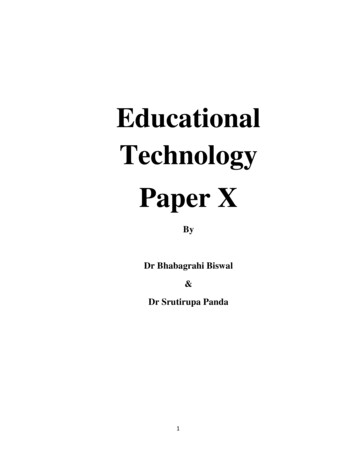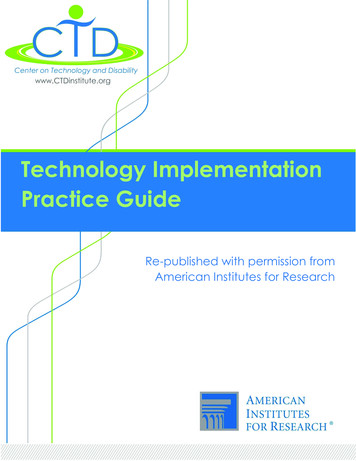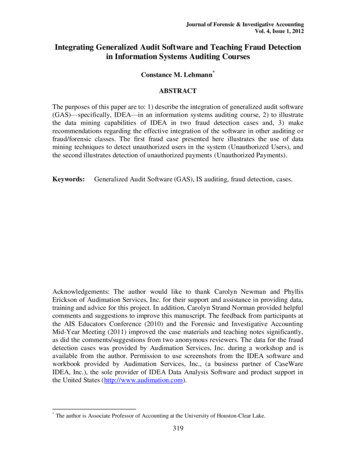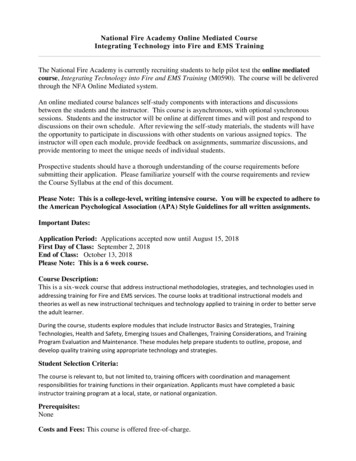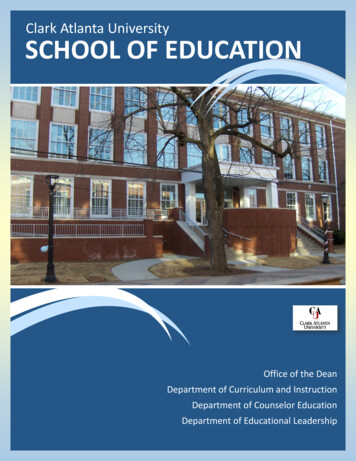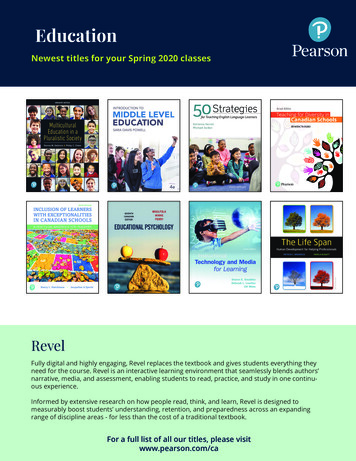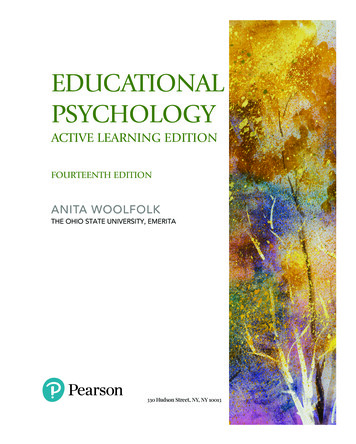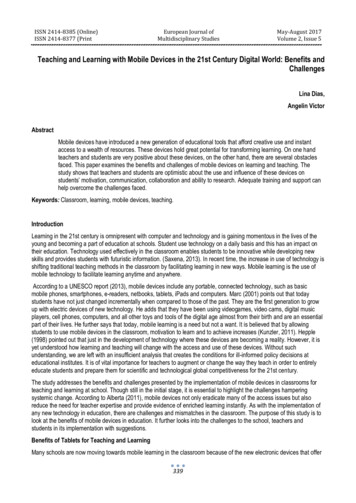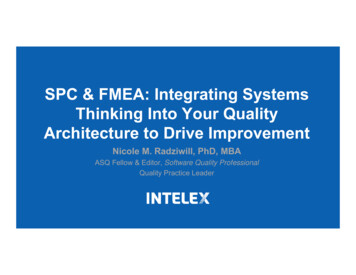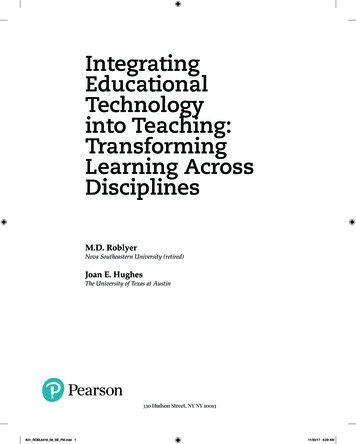
Transcription
IntegratingEducationalTechnologyinto Teaching:TransformingLearning AcrossDisciplinesM.D. RoblyerNova Southeastern University (retired)Joan E. HughesThe University of Texas at Austin330 Hudson Street, NY NY 10013A01 ROBL6418 08 SE FM.indd 111/30/17 6:29 AM
Editorial Director: Kevin DavisPortfolio Manager: Drew BennettManaging Content Producer: Megan MoffoSenior Content Editor: Max Effenson ChuckContent Producer: Yagnesh JaniPortfolio Management Assistant: Maria FelibertyDigital Development Editor: Krista SlavicekSenior Digital Producer: Allison LongleyExecutive Product Marketing Manager: Christopher BarryExecutive Field Marketing Manager: Krista ClarkProcurement Specialist: Deidra SmithCover Design: Studio MontageCover Art: Hero Images/Getty Images; lisegagne/Getty Images; KaPeSchmidt/Getty Images;Syda Productions/ShutterstockEditorial Production and Composition Services: SPi GlobalFull-Service Project Manager: Heidi Aguiar, SPi GlobalPrinter/Binder: RR DonnelleyCover Printer: Phoenix ColorCredits and acknowledgments for materials borrowed from other sources and reproduced, with permission, inthis textbook appear on the appropriate page within the text.Every effort has been made to provide accurate and current Internet information in this book. However, theInternet and information posted on it are constantly changing, so it is inevitable that some of the Internetaddresses listed in this textbook will change.Copyright 2019, 2016, 2013, 2010 by Pearson Education, Inc. All rights reserved. Printed in the United Statesof America. This publication is protected by Copyright and permission should be obtained from the publisherprior to any prohibited reproduction, storage in a retrieval system, or transmission in any form or by anymeans, electronic, mechanical, photocopying, recording, or likewise. To obtain permission(s) to use materialfrom this work, please visit http://www.pearsoned.com/permissions/Library of Congress Cataloging-in-Publication DataNames: Roblyer, M. D., author. Hughes, Joan E., author.Title: Integrating educational technology into teaching : transforminglearning across disciplines / M.D. Roblyer, Nova Southeastern University(retired), Joan E. Hughes, The University of Texas at Austin.Description: Eighth Edition. New York : Pearson Education, Inc., [2018] Audience: Ages: 18 Identifiers: LCCN 2017043408 ISBN 9780134746418 ISBN 0134746414Subjects: LCSH: Educational technology—United States. Computer-assistedinstruction—United States. Curriculum planning—United States.Classification: LCC LB1028.3 .R595 2018 DDC 371.330973—dc23LC record available at https://lccn.loc.gov/201704340810 9 8 7 6 5 4 3 2 1Student EditionISBN 10: 0-13-474641-4ISBN 13: 978-0-13-474641-8A01 ROBL6418 08 SE FM.indd 211/30/17 6:29 AM
For Bill and Paige Wiencke, whose love is, asArthur Clarke said of advanced technology,indistinguishable from magic.—MDRFor my father Thomas A. Hughes (1933–2017)whose commitment to education and lifelonglearning is my inspiration.—JEHA01 ROBL6418 08 SE FM.indd 311/30/17 6:29 AM
About the AuthorsM. D. Roblyer was a technology-using professor and contributor to the field of educational technology for 35 years. She authored or coauthored hundreds of books, monographs, articles, columns, and papers on educational technology research and practice.Her other books for Pearson Education include Starting Out on the Internet: A LearningJourney for Teachers; Technology Tools for Teachers: A Microsoft Office Tutorial (with StevenC. Mills); Educational Technology in Action: Problem-Based Exercises for Technology Integration; and the most recent text, Introduction to Instructional Design for Traditional, Online,and Blended Environments (2015).Dr. Roblyer began her exploration of technology’s benefits for teaching in 1971as a graduate student at Pennsylvania State University, one of the country’s first successful instructional computer training sites, where she helped write tutorial literacylessons in the Coursewriter II authoring language on an IBM 1500 dedicated instructional mainframe computer. While obtaining a doctorate in instructional systems atFlorida State University, she worked on several major courseware development andtraining projects with Control Data Corporation’s PLATO system. In 1981–1982, shedesigned one of the early microcomputer software series, Grammar Problems for Practice, for the Milliken Publishing Company.Dr. Roblyer retired in 2015 after having served as teacher, professor, graduate student mentor, doctoral student dissertation chair and committee member, and leader inshaping educational technology’s changing role since 1969. She lives in Chattanooga,Tennessee, where she is active in local political and community work. She is marriedto fellow Florida State alumnus Dr. William R. Wiencke and proud mother of daughter Paige Roblyer Wiencke.ivA01 ROBL6418 08 SE FM.indd 4Joan E. Hughes has been a technology-using educator and contributor to the educational technology field for more than 25 years and has authored or coauthored morethan 100 journal articles, book chapters, proceedings, research conference papers, andpractitioner conference papers worldwide.After earning a bachelor of arts degree in English from Pomona College, she beganworking in the educational technology field as an elementary and middle school computer teacher in Silicon Valley area of California in the early 1990s. She presented oftenat the CUE Conference (known then as Computer-Using Educators) and coauthored herfirst book, The CompuResource Book, a collection of technology-supported lessons. Later,she pursued her doctorate in educational psychology with emphasis on cognition andtechnology at Michigan State University where she taught courses for preservice teachersin Michigan and inservice teachers internationally in Korea, Japan, Thailand, and England. Her earliest research developed the concept of technological pedagogical contentknowledge (TPCK), a theory generated from case studies of English teachers’ learningand use of technologies in schools. This theory has been adapted and adopted widely.Currently, Dr. Hughes is Associate Professor of Learning Technologies at The University of Texas at Austin where she conducts research and teaches about how teachersand K–12 students use technologies in and outside the classroom for subject-area learning and how school leaders support classroom technology integration. She serves oneditorial and review boards for several teaching and technology journals and has contributed to leadership of technology-related special interest groups. She is highly supportiveof her students’ educational objectives and has guided 47 doctoral and 45 master of artsand master of education degree students to complete dissertations, theses, or reports.She is married to Lee Klancher, a writer, photographer, and publisher (OctanePress). They spend time walking their dogs, running, biking, cooking, and eating inAustin and around the world.11/30/17 6:29 AM
PrefaceAbout This BookDuring a time when nearly everything else is changing rapidly and radically, the mission of this textbook has remained steady and consistent: to reflect the burgeoning,evolving role of technology in education. The book’s 20-year history has always documented new and significant transitions in the role of technology in education, and theeighth edition continues that work. But this edition also reflects a new kind of transition with Joan E. Hughes playing a lead role in the authoring team.This edition reflects fresh, new perspectives on using technology in teacher learning and leadership, an emphasis on transformative technology integration in theclassroom, and content-based technology integration. The text includes four sectionsthat position the reader as a teacher learner and leader of transformative technologyintegration. The first section provides the historical underpinnings of the field thatinform our current practices, the learning theories that shape pedagogy, and a technology integration planning model that leads to technology-supported pedagogy that isresponsive to instructional or learning challenges. It provides an extensive review ofthe mindsets and practices of teacher technology leaders who are problem solvers, useconnected learning strategies to continually learn and engage in the profession, builda compelling online professional identity, and employ a personal rationale for usingtechnology in all decision making. The second and third sections introduce the technological resources that support teaching and learning. The second section introducestechnologies for general productivity activities and instructional software for learningcontent. The third section reviews how the web supports teaching and learning. Itshares ways to access web-based content and engage in web-based communication,collaboration, design, creation, and making. Ultimately, educators use all these technological resources to build blended or online learning lessons or curricula. The fourthsection continues this book’s commitment to technology integration in disciplinarycontent areas with a chapter specific to the following content areas: special education;English and language arts (ELA); second and foreign languages; science, technology,engineering, and mathematics (STEM); social studies; music and art; and physical andhealth education. We go well beyond describing the technical features and capabilitiesof 21st-century technology tools to focus steadfastly on the research-based teachingand learning strategies that these resources can support in content areas.Across all eight editions of this book, we have strived to develop an enlightenedview of technology in education by using the following guidelines on best practices inmatching the needs of the educational community with technology’s capabilities. Good pedagogy comes first. Our experience with educational technologies hasshown more clearly than ever that the interaction between teachers and studentsremains an essential quality of effective education. This textbook proposes thattechnologies are, above all, channels for helping teachers communicate better withstudents—ways of making their instructional relationships more meaningful andproductive. Technologies can make good teaching even better; it cannot make badteaching good. Consequently, technology-using teachers can never be forces forimproved education unless they are first and foremost informed, knowledgeableshapers of their craft. Before integrating technology into their teaching, educatorsmust know a great deal, for example, about why there are different views on appropriate teaching strategies, how societal factors and learning theories have shapedthese views, and how each strategy can address differing needs.vA01 ROBL6418 08 SE FM.indd 511/30/17 6:29 AM
vi Preface Technology is us. Rather than seeing technology as some foreign invader here toconfuse and complicate the simple life of the past, teachers can recognize that technology is very much a response to overcoming obstacles that stand in the way of abetter, more productive way of life. Technology encompasses the tools we fashionand the ways we choose to use them to solve problems in our environment. Turmoil will accompany the transitions as teachers adapt to the new environment thatteachers have a large role in creating. But technology is, by definition, intended tobe part of society’s path to a better life rather than an obstacle in its way. We control how technology is used in education. Finally, we must recognize thetruth of Peter Drucker’s statement: “The best way to predict the future is to createit.” Both individual teachers and teaching organizations must see themselves asenlightened shapers of the future. Each teacher must help to articulate the visionfor what the future of education should look like; each should learn the knowledge,attitudes, and disposition that will help realize that vision.What’s New in the Eighth EditionBest known for its technology integration strategies grounded in strong research, theeighth edition of Integrating Educational Technology into Teaching: Transforming L earningAcross Disciplines offers a total technology integration framework across all contentareas. It also gives teachers practice with technology resources as they learn how toincorporate technology to support curriculum in ways that transform instruction andlearning. And as usual, this edition includes additions that reflect changes in the fieldof educational technology. NEW! All chapters’ learning outcomes are mapped to the applicable ISTE Standards for Educators (2017). All technology integration example lessons indicatethe ISTE Standards for Students (2016) that are addressed within them.Chapter Learning Outcomes Address the 2017 ISTE Standards for EducatorsChapter1 – Learner2 – Leader3 – Citizen4 – Collaborator5 – Designer6 – FacilitatorChapter 1XXXXXX7 – AnalystChapter 2XXChapter 3XXXXChapter 4XXXXXXXChapter 5XXXXXXChapter 6XXXXXXChapter 7XXXXXXChapter 8XXXXXXXChapter 9XXXXXXXChapter 10XXXXXXXChapter 11XXXXXXXChapter 12XXXXXXXChapter 13XXXXXXXChapter 14XXXXXXXChapter 15XXXXXXXX NEW! Chapters 1 through 3 have been updated to provide the research, theory,and pedagogical foundations for teachers to learn, plan, and lead transformativetechnology integration in their classrooms and schools. NEW! Chapter 2 introduces the Turn-around Technology Integration Pedagogyand Planning (TTIPP) model and the Replacement, Amplification, and Transformation (RAT) assessment model, which help teachers plan and implement classroomA01 ROBL6418 08 SE FM.indd 611/30/17 6:29 AM
Prefaceviitechnology integration. Each chapter opens with a detailed Technology Integration in Action scenario and ends with a Technology Integration Workshop, bothof which incorporate the TTIPP model and RAT assessment processes and requirelearners to apply them. NEW! Chapter 3 is a new chapter focused on teacher learning and teacher leadership for technology integration, which specifically address the first two ISTEStandards for Educators (2017), Learner and Leader. The chapter highlights themindsets of leaders, connected learning, online professional identity, and the needfor a personal rationale for using technology in teaching. NEW! Chapters 4 through 7 have been reorganized to sequentially introduce technology and web-based resources for teaching and learning. Chapter 8 focuses onblended and online (virtual) learning pedagogy. Teachers can select and incorporatetechnology resources introduced in the preceding Chapters 4 through 7 to supporttheir digital blended or online instruction. NEW! Each discipline-specific chapter (Chapters 9 through 15) culminates by offering strategies for continued teacher learning and leadership in content-specific integration. Each includes a rubric that teachers can use to direct and self-assess theirgrowth in technology integration and suggested Twitter hashtags to follow. UPDATED! Experts in each of the content areas (in Chapters 9 through 15) haveupdated each Top Ten Must-Have Technologies and present apps that are widelyused in each discipline area; examples help educators see the role these tools arebeginning to play in education. UPDATED! All chapters provide updated research and illustrate how new technology resources and/or strategies are being used in the classroom.Key Content Updates by Chapter Chapter 1. This chapter includes a revised definition of integrating educationaltechnology that aligns with the TTIPP model introduced in Chapter 2 and is usedthroughout the book. The foundations of educational technology were updated toinclude learning sciences and the current era of the personalization of educationand adaptive learning. The most current ISTE Standards for Educators (2017) andStudents (2016) are included as is a description of the TPACK framework of teacherknowledge, including examples of the knowledge in practice from Dr. Hughes’most recent research. Chapter 2. This chapter now emphasizes transformative technology integrationthrough revision of the previous TIP model into the TTIPP model, which beginswith problems of practice; involves teachers in understanding the technologicalresources of their learners, families, and schools as assets for planning; and includesthe RAT assessment model for determining relative advantage of technology inlessons. Chapter 3. This all-new chapter positions teachers to be lifelong learners and technology leaders for change. The chapter describes the mindsets of teacher leaders;positions teachers as connected educators who participate in connected learningcommunities; encourages teachers to build a compelling and consistent online professional identity; and explains how to build a personal rationale for using technology in teaching. Chapter 4. This chapter (previously Chapters 4 and 5) opens with a new sectionon technology device and software configurations in classrooms and schools andtheir capabilities in supporting different pedagogical approaches. A new definitionis used to describe technology used for productivity: Hardware and software toolsthat do not contain predesigned curricular content; instead, teachers and studentsA01 ROBL6418 08 SE FM.indd 711/30/17 6:29 AM
viii Prefacebring content to their activities with these resources. Productivity tools are used forwriting and publishing; representing ideas or content using multimedia; collectingand analyzing data; planning and organizing; generating instructional materialsand forms; and assessing student products. Chapter 5. This chapter (previously Chapter 3) introduces instructional softwarewith an updated definition: preprogrammed content material that often is instructionally sequenced. The chapter includes a new section on strategies for selectingappropriate instructional software. Chapter 6. The chapter was reorganized to introduce the web and its use as aresource for archived, immersive, or live content. It includes broadened descriptions of the web, online safety and digital citizenship, and web search strategies. Ithas new sections on web content (archived, immersive, and live), open educationalresources (OER), and an introduction to Creative Commons. The new final sectionintroduces evaluation criteria for determining the ease or difficulty of integratingweb content into instruction. Chapter 7. This chapter (including some content from the previous edition’s Chapter 6) introduces web resources that support communication, collaboration,design, creation, and making. Key new additions include content curation; multimodal creative expressions; digital publishing, storytelling, and book making;and a computer programming section describing computational thinking, coding,visual programming, designing and developing games and apps, building in virtual worlds, building augmented reality, and making. Chapter 8. This chapter (previously Chapters 7 and 8) provides updated definitions, benefits, challenges, examples, and integration strategies of blended andonline (virtual) learning and describes how readers can use the content in preceding Chapters 1 through 7 to build blended or online learning experiences. Keyadditions include descriptions of teacher competencies for blended/online instruction, characteristics of successful online courses, and national standards for qualityonline courses. Chapter 9. This chapter (formerly Chapter 15) was repositioned in the book toemphasize its unique role cutting across teaching and learning activities in allschool content areas to meet all learners’ needs. The introduction to special education reflects current laws and the current distribution of students with disabilities.The chapter also reviews additional ways in which mobile devices are used asassistive technologies and includes a section that helps readers learn how to selectbest technology apps for students with disabilities. Chapter 10. The key updates in this chapter (formerly Chapter 9) include technological possibilities for literacy practices in relation to broader mobile device accessat home and at schools and expanding social media activities. It also emphasizesthe need for digital literacy and digital citizenship among teachers and youth. Chapter 11. The predominant updates in this chapter (formerly Chapter 10) revealthe most recent national characteristics of English learners, responsibilities andstrategies for language learning by all content-area teachers, and the latest technological strategies and innovations that support language learning through computer and mobile technologies. Chapter 12. The first section of this updated chapter (previously Chapter 11) nowintroduces the science, technology, engineering, and mathematics (STEM) fields,articulates how teachers can integrate STEM, and sets forth an integrated view ofthese content areas. The chapter now includes new sections on the challenges ofand technology integration strategies for engineering to complement the scienceand math sections.A01 ROBL6418 08 SE FM.indd 811/30/17 6:29 AM
Prefaceix Chapter 13. This chapter (previously Chapter 12) emphasizes the competingadvantages and challenges of web-based content: plentiful access to source materials in every social studies topic area but also widespread inaccurate and misleadinginformation and hateful and malicious falsehoods posing as informed facts. Thus,the importance of digital literacy and digital citizenship thread throughout thechapter. Finally, it includes a new section on the integration of social media. Chapter 14. Content in this chapter (previously Chapter 13) reflects recent changesin the standards by the National Association for Music Education (NAfME) and theNational Visual Arts Standards. Key updates include the influence of Bring Your OwnDevice (BYOD) on music and art teachers’ options and new technological innovations,such as those supporting live performance and increasing access to online artwork. Chapter 15. This chapter (previously Chapter 14) has been updated and reorganized around the Whole School, Whole Community, Whole Child (WSCC) model,notably introducing technology integration strategies for physical activity andhealthy living: (1) before and after school, (2) during school, (3) with staff involvement, and (4) with family and community engagement.Revel Digital LearningREVEL is Pearson’s newest way of delivering our respected content. Fully digital andhighly engaging, REVEL offers an immersive learning experience designed for theway today’s students read, think, and learn. Enlivening course content with m edia interactives and assessments, REVEL empowers educators to increase engagementwith the course to better connect with students.REVEL offers dynamic content matched to the way today’s students read,think, and learn, including: Integrated Videos and Interactive Media. Integrated within the narrative, videosempower students to engage with concepts and take an active role in learning.REVEL’s unique presentation of media as an intrinsic part of course content bringsthe hallmark features of Pearson’s best-selling titles to life. Interactive Check Your Understanding (CYUs). At the end of every major section, each chapter’s learning outcome is assessed through a formal evaluation withfeedback. These evaluations help readers review the concepts and ensure that theymaster each chapter outcome. Video Examples. Each chapter includes multiple video demonstrations or commentaries from practitioners in the field that illustrate the concepts introducedin the chapter. Readers can view the technology-supported practices in action oridentify key practitioner-based strategies for success. Application Exercises. Each chapter has several interactive formative assessmentexercises that call on readers to apply their developing knowledge and receiveexpert feedback. For example, readers interpret key strategies from a video-basedinterview or classroom practice, fill in the blank with missing concepts in text-basedscenarios, identify or move concepts within a visual-based representation, viewmultimedia examples, or match concepts with drag-and-drop text. Shared Writing. Each chapter includes at least one chance for readers to contemplate a unique scenario-based situation related to the chapter content and sharetheir thinking through a collaborative Shared Writing exercise. Interactive Glossary. Bolded key terms in the text are linked to glossary definitions, enabling students to read and comprehend with clarity without skippingconcepts they do not understand.A01 ROBL6418 08 SE FM.indd 911/30/17 6:29 AM
x PrefaceCore Principles of this TextThe purpose of this book is to show how teachers can shape the future of technologyin education. How teachers respond to this challenge is guided by how the authorssee it helping educators accomplish their own informed vision of what teaching andlearning should be. Our approach to accomplishing this rests on four premises:1. Integrating educational technology should be based in learning theory, teachingpractice, and curriculum. There is no shortage of innovative ideas in the field ofeducational technology; new and interesting methods come forth about as oftenas new and improved gadgets. Those who would build on the knowledge of thepast should know why they do what they do as well as how to do it. Thus, varioustechnology-based integration strategies are linked to well-researched theories oflearning, and we have illustrated them with examples of successful practices basedon these theories.2. Uses of technology should match specific teaching and learning needs. Sometechnology resources have the power to improve teaching and learning. Therefore,each resource should be examined for its unique qualities and potential benefitsfor teachers and students. Teachers should not use a tool simply because it is newand available; each integration strategy should be matched to a recognized need.Teachers should not oppose experimentation but advocate for informed use.3. Old integration strategies are not necessarily bad; new strategies are not necessarily good. As technologies change and evolve at lightning speed, there isa tendency to throw out older teaching methods with older machines. Sometimesthis is a good idea; sometimes it would be a loss. Each of the integration strategiesrecommended in this book is based on methods with proven usefulness to teachersand students. Some of the strategies are based on directed methods that have beenused for some time; other strategies are based on the newer, constructivist learningmodels. Each is recommended on the basis of its usefulness toward solving learningneeds rather than its age.4. A combination of technological, pedagogical, and content knowledge is necessary. This textbook maintains that teachers not only need to know the content they are teaching and good pedagogical strategies for connecting studentswith content but also must recognize how to integrate technology into pedagogyto achieve greatest impact on desired outcomes. In other words, teachers needwhat the field now refers to as Technological Pedagogical Content Knowledge,TPCK or TPACK.The goal of this edition is for teachers to see more clearly their role in shaping thefuture of technology in education. This book illustrates that great education meansemploying technologies to fulfill the vision they make possible—a worldwide socialnetwork and a global community that learns and grows together.A01 ROBL6418 08 SE FM.indd 1011/30/17 6:29 AM
Teaching and Learningwith Technology inSocial StudiesBy Daniel G. Krutka and Joan E. HughesFeatures of this TextLearning Outcomes68 Chapter 2After reading this chapter and completing the learning activities, you should beFor the eighth edition,abletheto: authors maintain a cohesive, comprehensive technologyTable 2.7 Technology Possibilities with Potential for High Relative Advantageintegration framework13.1thatbuildson strongresearchand numerousIdentifyimplicationsfor technologyintegrationof each currentintegration stratProblems of PracticeTechnology Possibilitiesissue or challenge that social studies teachers face. (ISTE Standardsegies. This Technology epts are new, foreign(e.g.,Graphic tools, simulations, video-based problemfor Educators: 1—Learner; 3—Citizen;4—Collaborator)mathematics,physics principles)scenariosConcepts are abstract, complex (e.g.,13.2 Select technology integration strategiesthat can meet variousphysics principles, biology systems)Math tools (Geometer’s SketchPad, simulations,problem-solving software, spreadsheet exercises,graphing calculators)Graphics displays make abstract concepts moreconcrete; students can manipulate systems to seehow they work.Tool software (e.g., word processing,spreadsheets and probeware)Takes low-level labor out of high-level tasks;students can focus on learning high-levelconcepts and skills.Introduces Teachers to Technology Integrationneeds for instruction in social studies. (ISTE Standards forskills (e.g.,Educators: 1—Learner; 2—Leader;Time-consuming3—Citizen; manual4—Collaborator;handwriting, calculations, data collection)5—Designer; 6—Facilitator; 7—Analyst)interfere with learning high-level skillsRelative AdvantageVisual examples clarify concepts and applications. DrillTechnologyIntegrationin Actionexamplesand practice software, instructionalgamesAttention-gettingdisplays, immediatefeedback,and interaction combine to create motivatingpractice.located at the beginning of Chapters 2 throughTechnology Integration in Action:Students cannot see relevance of concepts Simulations, Internet activities, video-basedVisual, interactive activities help teachersto their lives (e.g., history, social studies)problemrelevance.15 scenariosare classroom-based demonstratescenariosthat provide aProducing Authentic Historical InterviewsSkills are “inert” (i.e., can do
first book, The CompuResource Book, a collection of technology-supported lessons. Later, she pursued her doctorate in educational psychology with emphasis on cognition and technology at Michigan State University where she taught courses for preservice teachers in Michigan and inservice tea

